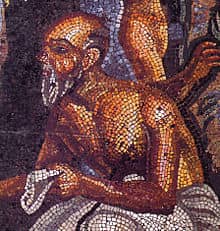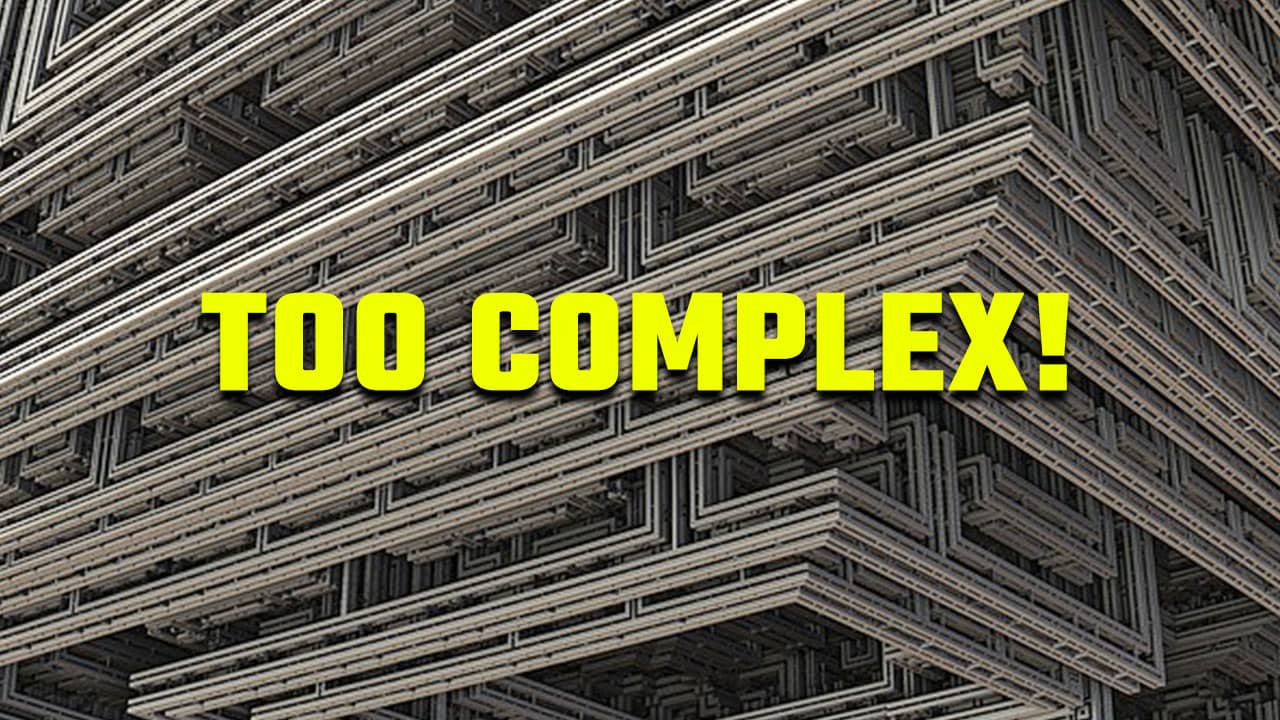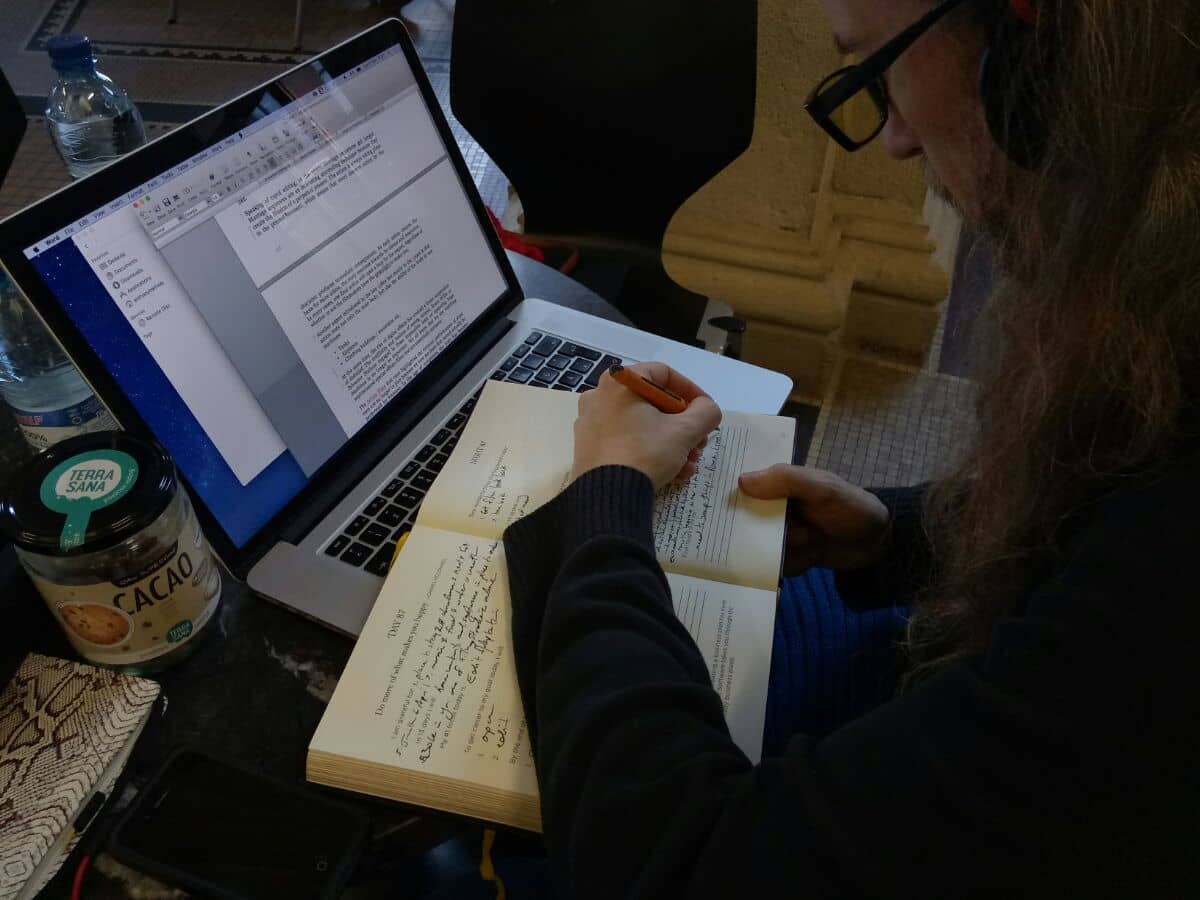Podcast: Download
Subscribe: Apple Podcasts | RSS
 Are you intimidated by the method of loci?
Are you intimidated by the method of loci?
Do you feel a thousand miles away from the Sherlock Holmes levels of memory you want to possess?
If so, don’t worry. It’s not your fault.
First off, people often scratch their heads at the term. And no wonder. It’s ancient and many people have to spend precious time wondering how to even pronounce “loci”.
And then they get hung up on alternative terms, like “Memory Palace” and “Mind Palace.”
That’s understandable.
After all, the word “palace” brings to mind an elaborate dwelling.
It’s huge.
And complicated, right?
Well, only if you use the technique that way. But it certainly doesn’t have to be anything other than fun and easy. And that’s what this post is all about: making this memory method an absolute delight that helps you accomplish your learning goals
What Is The Method of Loci?
Loci is the plural of locus, meaning a place or locality. Thus, the method of loci is a strategy for stringing together a number of places along a journey used to help us recall information.
It is synonymous with phrases like “Journey Method,” “Memory Palace” or “Mind Palace.” You can use the technique to:
- Memorize speeches
- Commit numbers to memory (including up to 100,000 digits)
- Learn languages
- Remember names
- Pass exams
- Win memory competitions
- Set records
- Read and understand more thoroughly
- Enjoy a great quality of mind
And there’s a good reason people still use this ancient term:
The terms “loci method” or “method of loci” mean at their core that we’re turning space itself into a mnemonic device. I think of this memory tool as a “location-based mnemonic.”
No one knows exactly where the term comes from. But memory expert Frances Yates details how the Greek tradition of memory entered into the medieval world through Rome in her book The Art of Memory.
The Greeks attributed the loci technique to Simonides of Ceos, but as Lynne Kelly demonstrates in The Memory Code, it’s actually much older. In fact, Aboriginals and other cultures around the world have been using the sky and landscapes to help them remember information since prehistorical times. Using the sky as part of the method of loci is sometimes called a “Songline,” just one of several ancient memory techniques.
It was probably the Romans who influenced the development of the term Roman Room, which is yet another variation of this term.
Whatever you choose to call it, “method of loci” is here to stay. And since this term can also mean the center of an activity or a power, it’s as good a way to frame it as any.
Why?
Because when you understand the power of this memory technique, you can increase your learning speed and retention, literally almost over the course of a weekend.
How the Method of Loci Works
Our ancestors noticed that we naturally tend to remember where things happened. We now call this spatial memory and training specifically to pair information more tightly with locations has been shown in scientific studies to produce superior memory.
You can test how the method works quite easily by thinking back to a location from your childhood or youth. For example, think about where you went to elementary school or high school. Mentally walk around. Most of us will be able to reconstruct a fair amount of these buildings.
As an additional exercise, see how many teachers and friends you can name by thinking specifically of the classrooms where you spent time with them.
Following exercises like this sets you up with locations you can use formally with the technique. For example, I had a grade nine science teacher named Mr. Ralston. When I had to memorize the name of a philosopher named Rawls and a few of his ideas, I instantly used the method of loci in Mr. Ralston’s classroom.
How To Get Started With the Method of Loci for Memory Training
Success begins with the decision to get started and learn the methodology.
Personally, whenever I get stuck on how to best use the technique, I mind map out as many method of loci examples as I can.
But let’s take things a step further.
I want to help you learn the loci method well and in a way that is completely stress-free.
That’s why I’ve put together these nine practical tips that will help you practice the technique once you’ve learned it.
Let’s dive in.
#1: Learn To Use The Method of Loci Simply
This means exactly what you think.
No clickbait here. Just keep it simple.
Don’t overcomplicate or overthink the loci technique.
It’s easy to overthink and analyze, of course. It’s in our nature, right? Well, we can still scrub it out.
To make it simple, start with just 5-10 loci. Yes, you can build up to hundreds, if not thousands of loci, but use will they be if you don’t know how to reliably use just a handful?
Keep it simple and then follow the next step.
#2: Add Complexity To Your Method of Loci Strategy As Your Skills Grow
Just because we want to keep things simple, doesn’t mean we’re going to remain simple forever. Adding complexity as your skills grow is important.
For example, your first simple Memory Palace of your childhood bedroom can grow to include:
- Your entire home
- Your block
- The walk to school
- The drive to work
- Churches, cafes, art galleries
- Other method of loci examples
But before you expand, you’ve got to get good with just one execution of the method of loci, ideally by drawing out the journey from station to station by hand.
That means starting with your existing competence. Don’t overcomplicate things.
With practice, you will see that there are some places where simplicity will always rule and complexity is not desirable.
Ever heard of the phrase, “Just because you can, doesn’t mean you should?”
That’s a great rule of thumb to keep in mind when using this memory method.
#3: Use Different Sized Journeys
Once you have grown your practice to where you have built several palaces, you’ll want to have a way of linking them together, right? This is where the Method of Loci, or journey method comes in.

The matter of size when using the method of loci goes at least as far back as Simonides of Ceos, who is thought to have discovered the technique after recalling the names of people after they died in a tragic earthquake.
His use of the technique was obviously not that big, since banquet halls in the ancient world probably weren’t as big as our contemporary shopping malls.
Nonetheless, writers like Thomas Aquinas, Giordano Bruno and Matteo Ricci all recommended small distances between the stations.
Some of the ancient texts are very specific and say you should have five feet between stations. Others recommend much more space.
Consider this, however:
These ancient memory experts lived in a different era.
They did not have the compact buildings and roadways that we enjoy now. They definitely didn’t have this great method of loci book list.
If they had, I believe they would have made very different choices when using the kinds of memory techniques Boris Konrad used to establish Guinness World Records and Anastasia Woolmer used to combine memorization techniques with dance.
You can use very big journeys, or small ones. You can use entire buildings or your body.
The point is to know the purpose of why you’re using the method of loci.
You can have shorter and longer journeys and more complex and simpler journeys. You can have a variety and have each serve you differently, so long as you’re clear about what you want these spatial memory tools to help you remember better.
Have I tried used Mega Mind Palaces myself? You bet, but always with mixed results.
#4: Use White Space
“Less is more.”
While it can be useful to have very condensed Memory Palaces, and those can be filled and overloaded with tons of stations, it can also be very beneficial to see what happens when you have less. Try working in a manner that’s spaced out, instead of overloaded.
You can apply this idea to not only your use of the method of loci, but what you encode when using it. Memorize less, encode less, and see if you’re able to have more recall from focusing on fewer pieces of information.
The goal is to avoid the “Dr. Faust effect.”
The legend of Faust warns us against a downfall caused by a greed for all knowledge. He was unsatisfied with a mastery of law, logic, science and theology, and turned to the dark arts, where he eventually was damned after he sold his soul to Mephistopheles for more knowledge.
Instead of just collecting information, and never feeling satiated, why not be satisfied with the big ideas, and having an appreciation of the “white space”? You’ll find that your mind will fill in the blanks and you don’t need that overload of information. The white space will take care of itself. Let your Memory Palaces breathe.
#5: Complete Both Short Term And Long Term Projects
To keep your practice fresh, have both short and long term projects you are working towards.
A classic short term project is to have a daily run through of memorizing playing cards. Keep a deck handy (maybe beside your coffee pot in the morning, or near your reading nook) so you can shuffle and memorize a handful in your downtime.
For a longer term project, this may be learning a new language, studying human anatomy or memorizing a collection of poetry.
Toggling these two projects will keep you from becoming bored and burnt out with a singular goal.
#6: Explore Indoor vs. Outdoor Options
As you move toggle between short and long term projects, explore using indoor and outdoor locations for your memory journeys.
As an alternative to viewing your memory tools as simply one large Mind Palace, what if you thought of it as a collection of smaller locations?

For example, a home is a collection of room, a room a collection of areas and corners. A park can be seen as a playground area, hiking trail, community pool.
(Or you can skydive and wander your Memory Palaces like Kevin Richardson does while using Recall Rehearsal for learning Japanese with mnemonics.)
Be flexible and bring a sense of playfulness to using this memory technique. It will be far more beneficial as you develop living and growing entities using the method of loci instead of a static, fixed creation.
For more on using outdoor locations, check out my discussion with Lynne Kelly on the craft of memory.
#7: Understand That The Method Of Loci Creates Pegs To Which You Can Add Pegs
Think of each spot you create using the method of loci as a peg to which you can add pegs. In other words, each is a space to which you can add a peg.
When people first get started with memory techniques they may see these tools as mutually exclusive, instead of elements that can be used in partnership.
Yet, the Peg System works exactly how you would imagine, pegging or linking one thing to another. Building upon what you do know, you connect the new information to it in your mind.
(No, peg system is not that different from the pegword method, but it’s worth exploring both.)
#8: Persist with S.I.P.
Now even though I’ve broken down mastery of the Method of Loci down to nine simple tips, it may not always be easy peasy. You will be faced with challenges along the way. There’s just no getting around it. Success with these methods is not about not having those setbacks, but that you know how to deal with them.
And one of the best ways to deal with those challenges is to make sure you have a good library of memory training.
Use all of the information you have available to you. Utilize it constantly and consistently. Take S.I.P. to heart:
S = Study the techniques for yourself consistently over time
I = Implement what you learn from your study of memory techniques and its tradition.
P = Practice these techniques with information that improves your life.
Be ever vigilant in tweaking your practice and improving it. As Nicholas Castle found, this practice can release you from some big problems in life, as it did with his PTSD.
#9: Keep A Memory Journal
Finally, keep a memory journal. It is crucial to have a place, a record of what you’re doing, how you’re doing it. Only then are you able to proceed and know where you’re going if you know where you’ve come from.
Although you could use something like Evernote for better memory journaling, I personally don’t see the attraction.
Instead, consider going back to “keep it simple.”
#10: Treat Using Your Loci Like A Game
One of the best ways to enjoy the process of using this memory technique is to not take things so seriously.
When I invented my game, Memory Detective and wrote the mystery novel Flyboy, this was my attempt to help people maximize their own fun with the learning experience. You can read my novel and learn the techniques along with the detective. Or when you play my game, you can get passive memory exercise and active memory exercise in a fun community.
The memory competitions also bring a level of gamification to memory training, or you can create your own process. For example, when using the loci method, you can set a timer. Or you can role dice to determine how many of your loci you’re going to use during a single learning session.
The important thing is to have fun so that you can learn and practice memory techniques in ways that you find mentally stimulating.
Benefits of The Method of Loci
People report many benefits of using this particular memory method.
One of the most exciting developments in recent years comes from Dr. Tim Dalgleish. He’s shown that using the method of loci can help alleviate symptoms of depression. I’ve enjoyed this benefit personally, something I reported on at length in my most popular book, The Victorious Mind.
Other benefits include confidence, getting a raise or promotion, or even starting a career as a professional mnemonist.
I’ve also had many of my students on the podcast who have:
Although many people come to the method of loci in order to pass exams, the outcomes are incredibly diverse.
Getting The Method of Loci Right The First Time
A memory journal also helps you get it right the first time. I highly recommend that you draw when using the method of loci. No software. I’m talking about using pencil or ink on paper.
Sure, method of loci software might be an option for some, but for the majority of us, I think it reduces our abilities. We need to train our brains to think spatially and in concrete terms.
This was one of the key points covered in Rhetorica Ad Herennium, one of the key memory training books from circa 90 BCE.
Drawing helps you quickly “see” your Memory Palace journeys better in your mind. This is because you create them visually on the page and strategize them before using the Method of Loci.
Taking this simple step saves on mistakes and allows you to avoid the feeling that you may need to “renovate” your Memory Palaces later.
I know that this can seem like a lot of work in the beginning. If you’re feeling overwhelmed, just start with just one of the tips on this page.
See how implementing it improves the ease and speed of which you can create palaces and progress through the Method of Loci.
Mix and match these principles to maximize your efforts and you’ll see just how effortless the process can be with practice over time. Then move on to these more advanced Method of Loci training exercises.
Related Posts
- 5 Memory Palace Examples To Improve Your Memory Training Practice
Here are 5 Memory Palace examples that will improve your memory training practice quickly, even…
- How to Improve Memory: 18+ Proven Memory Improvement Tips
Do you want to know how to improve memory? This ultimate guide delivers 18 actionable…
- How to Improve Short Term Memory: 7 Easy Steps
Many people think you cannot improve short term memory. In truth, you can. Enjoy these…








14 Responses
Thank You for this post. In the past I tried stuffing my Memory Palaces thinking that having copious amounts of Info in one place was beneficial.
Once I switch to minimizing information and leaving white space between my magnetic staions, is when I began to easily recall the info.
Thanks again for your training, it has truly added great value to my life.
So glad that you found this useful, Adolfo.
I think in the beginning, most of us try to cram. I certainly did – and it’s dangerous because it actually can work. But things get so much better when we let it breathe.
It’s an honor to have you in the MMM Familia – you’re taking action and, as the hip kids say, “crushin’ it.”
Keep going!
Hi Anthony Metivier! I have two journals. One is for dreams, the other is for vocabulary and notes about the MMM Masterclass.
Thanks for stopping by, Maricela.
It’s great that you’re keeping more than one journal. I have always found segmenting them for different purposes to be useful myself.
Basically, keep your memory training complex but not too complicated.
I liked the idea of using white space. I’m going to give a try.
Thanks, Dexter.
Another way of thinking about it is that we need challenge in order to grow. Complexity can provide that challenge, but only if we have the existing competence needed to bear enough of the load. Many people take on too much complexity before they’re ready for it.
The opposite problem is that people set challenges that are too easy. They don’t grow and they get bored.
That’s why it’s important to tailor everything and re-tailor it with continual analysis of yourself. The Memory Journal is the perfect device for doing this.
Thanks for posting and look forward to hearing from you again soon!
I enjoy listening to this and all of the podcasts on the site. My only confusion is when you use the word “networks” as I keep thinking of networking as in computers. Still, I love this. Thank you, Anthony.
Thanks for checking this out and mentioning the term, Memory Palace Network.
I looked it up and it seems that “network” actually comes from the 16th century, long before computers. Anything with intersecting lines or some kind of mesh might get this term, such as a “chain” of islands. In the 1960s, quite some time after telephones and computers, it was applied to groups of people connected by such devices. In other words, the Magnetic Memory Method Family is a “network” of individuals who care about the memory tradition.
In terms of a network of Memory Palaces, this means having multiple Memory Palaces that are “connected” or “chained” together by using a generative and organizational device, such as the alphabet. For example, if I knew your home, it would be a “J” Memory Palace, whereas the home of Dexter, also in this conversation, would be a “D” Memory Palace.
It’s a tremendously useful way of creating a network and mentally organizing it, and organization was something the ancients placed a premium on. I believe we should too.
As an alternative to an alphabetical Memory Palace Network, you could encode them using a 00-99 PAO, but that will require much more heavy lifting than just working with the alphabet.
Does this help answer the mystery of this term for you? 🙂
It definitely does, Thank you, Anthony.
My pleasure. Thanks for asking such a great question!
Thanks Anthony, this is very rich. Does reconstruction of Memory Palaces based on old homes you lived in trigger old memories too? I was shocked at the level of detail I recall from the homes (and dorms from boarding school) that I remembered as I listed my former residences as Memory Palaces.
Old friends and teachers popped up too.
Amazing!
Laurian
Hi Laurian,
Yes, having old memories pop up happens frequently.
The most interesting thing I find is that by regularly going back to them, even more memories come up. It’s as if the well is never quite dry.
For example, your post prompted me to think of the second home I lived in and two of my dad’s friends came to mind. I thought I’d dug up everything from this one, but obviously not.
Even better, a song one of them used to play came to mind – I’m listening to it now with great pleasure after decades. Many thanks for stirring up some powerful and fun memories!
Can I create my memory palaces with my eyes open? I feel a great distress when I have my eyes closed for more than a few seconds. I even have difficulty meditating because of this, and I don’t know what’s happening?
Could you give me additional tips regarding this?
Yes, it’s possible to create Memory Palaces with eyes wide open. This is in fact how I teach people to do it.
My biggest tip is to learn the method of loci and related techniques from top to bottom. Find a book or course from someone you know, like and trust.
Put the instructions into use and practice them for at least 90-days so your brain has time to form new connections and develop better habits when dealing with learning information in this way.
It does still involve some repetition, but it’s creative repetition and much more interesting and effective for most of us compared to rote.